Journal of Geology & Geophysics
Open Access
ISSN: 2381-8719
ISSN: 2381-8719
Review Article - (2014) Volume 3, Issue 6
Tiles (Azulejos) on buildings in Iquitos, Peru represent the past glory of a city once known as the main port for the export of rubber. The tiles also indicated the border between the prosperous areas of the city and the poorer living areas of the country side. Although the decline of the rubber boom brought changes in the architect of the city, efforts have been made to preserve the heritage. This article provides information on the history of tiles and documents some of the patterns and uses.
Keywords: Tiles; Iquitos; Rubber boom
Azulejos, the glazed tiles that adorn buildings in Iquitos, Peru are more than a remnant of past glory in a city once known as the main port for the export of rubber. The tiles represent the fortunes of ambitious men, an indication of prosperous areas of the city, the evolving configuration of houses and buildings, and an unexpected defense against the climate. Azulejos buildings created a clear border between the countryside with its poorer living areas, and the urban center of Iquitos. As Sánchez [1] indicated, “architecture is one of the firmest languages of history,” and, I would like to add, geography.
Wealthy rubber barons in Iquitos built grand mansions and lived extravagant lifestyles. They dressed in fine Italian silk, drank French wine, imported musical instruments from Vienna, and modeled their homes after European mansions [2]. Another extravagance included ordering exquisitely painted tiles, known as azulejos, from Portugal and Spain to adorn buildings inside and out. The city transformed from a place of tambos (huts) to a major populated center reflecting the apogee of the rubber boom [3]. Although the rubber boom ended when the English were able to grow rubber trees in their own colonies, azulejos can still be seen on buildings in Iquitos. Buildings constructed after 1915 maintained architectural characteristics, but without iron and tiles [3].
The city of Iquitos is bordered by three rivers: the Amazon, the Nanay, and the Itaya. The jungle-locked city has no roads out and is accessible only by air or water. The name Iquitos means “land separated by the water.” Iquitos is the capital of the Loreto region and is located near the borders of Brazil and Colombia. In the late 1800s, Iquitos was the center of the rubber boom. Entrepreneurs and money poured into the area, as the demand for rubber products (shoes, raincoats, cable insulators, and tires for automobiles) increased [4].
With the increase in wealth, Iquitos changed from a small hamlet populated with huts to the center of a great commercial district with buildings constructed of brick, iron, glazed tiles, and marble. Streets were lighted, the first railroad built, and buildings with two stories and tall roofs appeared on the landscape [3]. Before the introduction of azulejos into Iquitos’ buildings, various types of architectural designs were created in the region that adequately responded to the challenges of the climate and environment. Hertz [5] described house designs that were architectural solutions to three regions of the country: the Andes, the Pacific coast, and the Amazon. Adobe houses, developed on the Pacific coast, stored heat and evened out temperatures, resulting in a cool house during the day and a warm house at night. With cold conditions and scarcity of fuel, the Andes region demanded compact homes with thick walls. The strong heat, humidity, and constant rain forced dwellers in the Amazon region to build open-air homes with adequate shade and ventilation. Buildings in urban areas can be categorized in years of construction by examining architectural styles and building materials [5]. Thus, the use of glazed tiles indicated buildings constructed during the rubber boom era.
Glazed tile responded well to the challenges of a tropical climate. The surfaces reflected heat and light, keeping the interiors cool, and were easy and cheap to maintain [6-9]. Tiles were also water resistant, fighting against mold and mildew. Iquitos experiences a noticeable wet season from November to May, with precipitation levels of around 11 inches per month. Ceramic tile is composed of clay that is pressed and then fired at high temperatures. It is a healthy building tool that is sustainable and will not harm the environment [8].
Azulejos have a 5000 year-long history that traverses across Asia, Africa and Europe. The Chinese produced baked ceramics pottery in ovens and the production process diffused throughout Korea, Japan and to North Africa and the ancient cultures of Mesopotamia [6]. The production of glazed clay tile has been attributed to the Egyptians. It was, however, the Muslim Moors of North Africa who spread the use to Portugal and throughout Europe [7,9]. The word azulejos comes from an Arabic derivative of “ac-zulaca or azzelij” meaning shining surface or flat smooth stone [9]. During the height of its wealth, Portugal exported tiles to its colonies, in particular Brazil in South America [9]. Early patterns on tiles were mostly geometric, as Islamic beliefs prohibited the drawing of live objects, but the predominantly Catholic Portuguese quickly added more exotic themes [7]. During the Baroque period, tiles in Portugal were glazed in blue and white, a reflection of the European interest in Chinese Ming-dynasty porcelains, but later tiles were patterned after Moorish rugs [9]. Tiles lined vaults, domes, stairways, pools, castles, park benches, monasteries, and even street signs throughout Portugal. Tiles were patterned in checker boards, or even kaleidoscopic designs. In some cases, hundreds of tiles were arranged to create one scene on a building [7]. Over the years, various themes were portrayed with tile images, from mythological subjects, to landscape themes to abstract and geometric patterns [9]. Colors for tiles come from various metal oxides: cobalt for blue, copper for green, iron for yellow, manganese for red, and combinations of these oxides for various other shades [6].
It was the establishment of a Provincial Council in 1887 in Iquitos that helped changed the urban settlement of Iquitos to a prosperous landscape. The Provincial Council team, under the leadership of José de Jesuse Réategui, began to implement changes in the landscape that included public lighting, sidewalks, delineated streets, a house numbering system, schools, and bridges [1]. Prior to the development of the team, businessmen concerned themselves mainly with the processes of securing and exporting rubber, with little thought to the comforts of daily life. During the apogee of rubber, European-style paved roads and the first stretch of railroad provided order to the community [1]. When comfort and luxury became a desired attribute of construction, buildings began to appear with tall roofs, wide doors and windows, wrought iron balconies, and colorful glazed tiles. The tile buildings in Iquitos splashed color across the background of green jungle and highlighted the comfort and luxury of the wealthy. One of the most impressive buildings was the Palace Hotel (Figure 1), a threestoried building on the corner of Malecon Boulevard and Putumayo Street.
Plans for the hotel were brought from Spain and all materials used for construction were imported from Europe, including the furniture and dishes [1]. Otoniel Vela acquired the property for a mere £1000 and began construction in 1908 [10]. Hand-painted tiles with various motifs varied according to their location in and on the building. Tiles were placed by floors with colors and stripes determined by the floor. The building currently serves as military headquarters for the region.
The decline of the rubber boom brought changes in the architecture of the city. Locally produced stucco and forged iron took the place of imported tiles [1]. Decorative fronts on buildings imitated the past luxuries and kept the strong tradition of artistic styling of housing and buildings without the expense of ceramic tiles. Neglect and destruction of historic buildings to make way for new construction contributed to the decline of the monuments of prosperity from the rubber boom era. Decades of over utilization of space destroyed many buildings that had great architectural value [3]. The age old battle of modernity v. historical identity permeated the following years. Fortunately for preservationists, some residents of Iquitos revered the historic icons of the past and have made efforts to preserve their heritage. The old Iquitos Boulevard (Malecon) that covered eight blocks from Ricardo Palma Street to Sargento Loreto Street has been restored (Figure 2).
The boulevard collapsed many years ago from erosion of the riverbank. In 1986, the Ministerial Resolution declared more than 80 real estates and monumental zones of Iquitos as cultural heritages [3].
Deterioration, alterations, and transformations of monument zones in Iquitos have destroyed real estate over the past years, contributing to a lack of identify with heritage [3]. For example, Casa Morey, located on the corner of Jirones Prospero and Brasil, was constructed in 1900 and covered with floral and geometric designed tiles (Figure 3).
It has suffered from alterations because of the desire to use spaces in the buildings for commercial activities, and has been covered with various layers of paint. The city of Iquitos still has many tile buildings standing today, not only because of the durability of the building material, but also thanks to the Resolution of Declaration of Monuments: Law #24047 which noted “that buildings from the Colonial period (1530s to 1820s of Spanish conquest) and Republican period (1824 to present day) will be declared Monuments because of their architectural, aesthetic, urban, historic, and documental worth, and should be conserved and their value must be posted” [11]. In a two block radius around the Plaza de Armas in Iquito (Table 1), are a number of existing buildings with tile exteriors. This area was the center of business and close to the port. The tile patterns from some of these buildings (Table 1) vary as much as the usages of the buildings, although several buildings had the same patterns. From private homes, to restaurants to casinos to schools, the tile buildings of Iquitos represent a vast socioeconomic change from the time of the wealthy rubber boom era.
| Tile Pattern | Description | Building | |
|---|---|---|---|
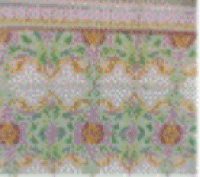 |
Glazed tiles of the Art Nouveau style with a white background and violet, green, orange, and cherry colored decorations | Private Residence 327-333 Putumayo | |
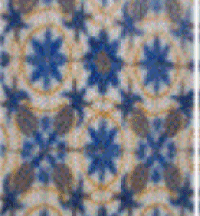 |
Glazed tiles with yellow pineapples that hug yellow circles that contain blue and yellow flowers | ColegioSagrado Corazon (High School) 290 Jr. Arica/SargentoLores | |
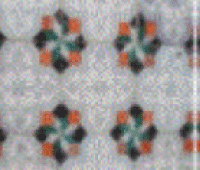 |
Glazed tiles that have a gray background with geometric designs of red, black, green, and white, and base boards in yellow, brown, black, gray, and white | CiruloCromatico Café/Bar 337 Napo, Cdra. 3 | |
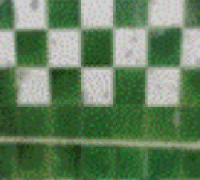 |
Green and white glazed tiles that form a checkered pattern with a green baseboard | Private Residence 172-196 Nauta | |
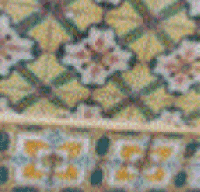  |
Buildings often used contrasting patterns with similar colors | Mad Mick’s 163 Putumayo Palace Hotel 200 Putumayo | |
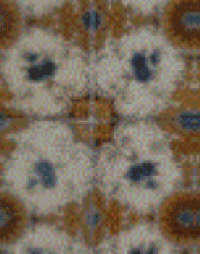 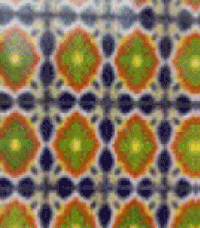 |
Kaleidoscopic patterns | Amazon Bistro 260 MaleconTarapaca Tropic Frio business 301 Jr. Arica | |
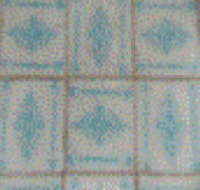 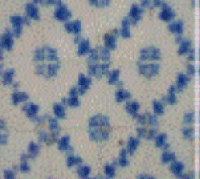 |
Blue and white tile patterns | Centro Educativo Particular Segundario 835 Crt. Lorel Construction/Medicine 319-321-326 Jr. RaymondiCadra. 3 | |
Table 1: Tile Patterns on Buildings near plaza de armas in Iquitos, Peru.